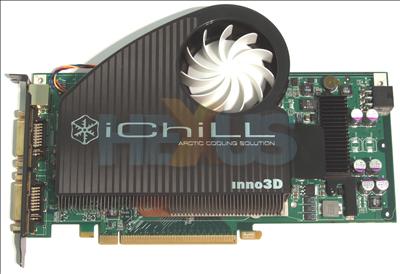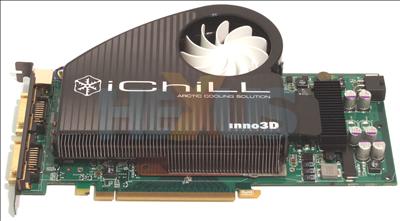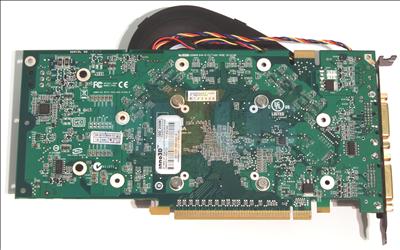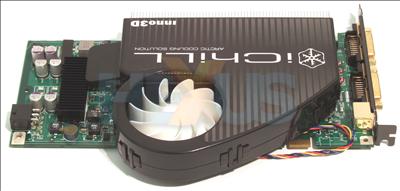Card appearance
Inno3D currently manufactures three distinct GeForce 8800 GT 512MiB cards. There's the stock-clocked version, shipping with 600/1,500/1,800MHz frequencies for the core, shader and memory, respectively, and retailing at around £155. The second of the triumvirate is the 'Overclock' model, which we reviewed here, shipping with 650/1,500/1,900MHz clocks. This model is now available for around £169.
Now, Inno3D leverages its alliance with Arctic Cooling and has released a premium iChiLL variant, outfitted with an AC Accelero X1 cooler and running at 700MHz for the engine and 2,000MHz for the memory. The shader speed, which is a key parameter in modern-day gaming performance, is left stock at 1,500MHz. We're nonplussed that Inno3D hasn't indulged in some shader-based overclocking, like many of NVIDIA's AIBs that manufacture 8-series cards.
The AC Accelero X1 heatsink and fan dominates the card. It ships with a copper base that makes decent contact with the core and also concurrently cools the 512MiB of super-fast GDDR3 memory that's clocked in, as we noted above, at an effective 2GHz. The onboard memory interfaces with the GPU via a 256-bit memory bus and yields a potential 64GB/s on tap, helping keep the core and shaders ticking along nicely.
The voluminous cooler will take up the expansion slot adjacent to the PCIe x16's, but we don't see this as a problem for the kind of consumer the card is aimed at - the enthusiast that wants a little more than stock performance out of the box.
The design is such that the curved heatsink does not interfere with the SLI connector on the right-hand side of the board, should you wish to add another and form a multi-GPU rendering setup.
With an ambient temperature of 22C, the sample card idled at 43C and ran at just 56C under full 3D load. That compares favourably with 'GT cards using the reference (read cheaper) heatsink that hit around 75C under load.
We reckon that Inno3D could have raised the core clock further, given the cooling present. However, it's not the quietest around and isn't thermostatically controlled, running at the same speed at all times.
The GeForce 8800 GT SKU consumes around 110W under load, necessitating an auxillary six-pin PCIe connector that you see present in the above shot.
If you buy into the bumf that's supplied with the card, the gold-plated connectors for the twin dual-link DVI ports are supposed to provide better contact and signalling. There's scant little evidence to suggest that regular connectors are inferior in transferring video out to your display, but it keeps in Inno3D's philosophy of only using premium parts for its iChiLL line.
The mini-DIN socket, on the left, is for exporting video only, and the days of card-based VIVO appear to be a thing of the past.
Summary
The consumer pays around £20 more for this model than the Overclock SKU, but, remember, the iChiLL ships with a better cooler and higher frequencies as standard. The only downside we can see is the lack of shader-based pre-overclocking.Thinking about the value proposition before looking at the benchmarks, the £189 asking price brings it perilously close to stock GeForce 8800 GTS cards. They're inherently faster, with 128 stream processors compared to the GT's 112.















